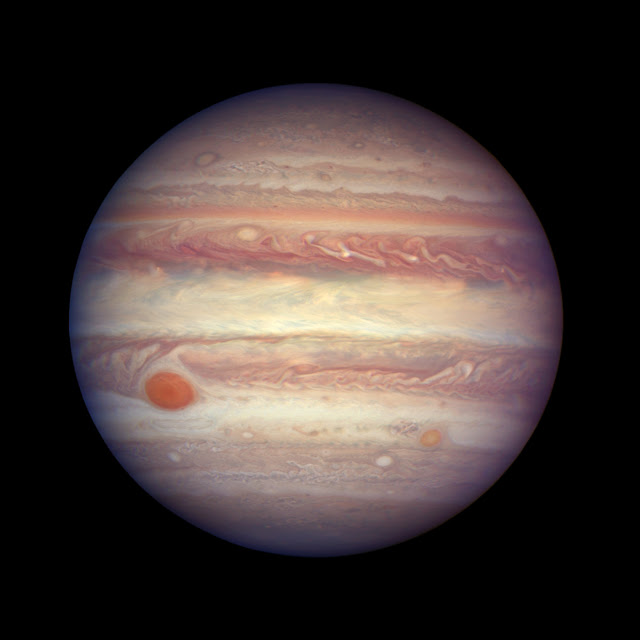Header
Modul
Thursday, April 6, 2017
Hubble takes close-up portrait of Jupiter
On April 3, 2017, as Jupiter made its nearest approach to Earth in a year, NASA's Hubble Space Telescope viewed the solar system's largest planet in all of its up-close glory. At a distance of 415 million miles (668 million kilometers) from Earth, Jupiter offered spectacular views of its colorful, roiling atmosphere, the legendary Great Red Spot, and it smaller companion at farther southern latitudes dubbed "Red Spot Jr."
This positioning allowed a team led by Amy Simon of NASA's Goddard Space Flight Center in Greenbelt, Maryland to observe Jupiter using Hubble's Wide Field Camera 3. Hubble photographed exquisite details in Jupiter's atmosphere, as small as about 80 miles (129 kilometers) across.
With its immense and powerful storms and hundreds of smaller vortices, the atmosphere of Jupiter is divided into several distinct, colorful bands, parallel to the equator. These bands, with alternating wind motions, are created by differences in the thickness and height of the ammonia ice clouds; the lighter bands rise higher and have thicker clouds than the darker bands. The bands are separated by winds that can reach speeds of up to 400 miles (644 kilometers) per hour.
Jupiter is best known for the Great Red Spot, an anticyclone that has raged for at least 150 years. This famous storm is larger than Earth. However, the Great Red Spot is slowly shrinking -- a trend seen since the late 1800s. The reason for this phenomenon is still unknown. Hubble will continue to observe Jupiter in hopes of solving this mysterious riddle.
The images are part of the Outer Planets Atmospheres Legacy program or OPAL. This program provides yearly Hubble global views of the outer planets to look for changes in their storms, winds, and clouds. It began in 2014 with Uranus, and has been studying Jupiter and Neptune since 2015. In 2018, it will begin viewing Saturn.
The team timed the Hubble observation to coincide with when NASA's space probe Juno would be near its closest point to Jupiter, so that scientists could get concurrent observations.
The Hubble Space Telescope is a project of international cooperation between NASA and ESA (European Space Agency). NASA's Goddard Space Flight Center in Greenbelt, Maryland, manages the telescope. The Space Telescope Science Institute (STScI) in Baltimore conducts Hubble science operations. STScI is operated for NASA by the Association of Universities for Research in Astronomy, Inc., in Washington, D.C.
Source: NASA/Goddard Space Flight Center [April 06, 2017]
About the Author

Unknown
Author & Editor
Has laoreet percipitur ad. Vide interesset in mei, no his legimus verterem. Et nostrum imperdiet appellantur usu, mnesarchum referrentur id vim.
Popular Posts
- Denmark's Bronze Age Skrydstrup Woman not Danish
- Restored Michelangelo crucifix gets pride of place at Santo Spirito basilica in Florence
- Almost complete skull of saber toothed cat discovered in Schöningen
- Newly discovered exoplanet may be best candidate in search for signs of life
- Hubble takes close-up portrait of Jupiter
- Paleontologists reappraise description of duck billed hadrosaurs
- Ancient zinc mining and metallurgy site discovered in China's Hunan Province
Labels
- Archaeology
- Europe
- Palaeontology
- Astronomy
- Universe
- Fossils
- Evolution
- Biology
- Genetics
- Southern Europe
- Earth Science
- Heritage
- Asia
- Near East
- Ecosystems
- Anthropology
- Climate Change
- Early Mammals
- North America
- USA
- Italy
- Natural Heritage
- China
- Geology
- Americas
- Astrobiology
- Canada
- Egypt
- Forensics
- Western Europe
- Ancient Environment
- North Africa
- Wildlife
- Astrophysics
- Dinosaurs
- Environment
- Ticker
- UK
- East Asia
- Endangered Species
- Greece
- Middle East
- South East Asia
- Biodiversity
- Early Humans
- Germany
- Indigenous Cultures
- Indonesia
- Iraq
- Israel
- Mongolia
- Northern Europe
- Oceans
- Origin of Life
- Spain
- Turkey
- Africa
- Antarctic
- Austria
- Central Asia
- Denmark
- Eastern Europe
- Exhibitions
- Iran
- Russia
- South Africa
- South Asia
- Syria
- Tibet
- Travel
- Alaska
- Australasia
- Belize
- Bolivia
- Brazil
- Bulgaria
- Burma
- Central America
- Cyprus
- Dominican Republic
- Early Birds
- Guatemala
- Human Evolution
- India
- Malaysia
- Mexico
- Morocco
- Neuroscience
- Norway
- Oman
- Papua New Guinea
- Portugal
- Rainforests
- Religion
- Siberia
- Slovakia
- Society
- South America
- Space Exploration
- Switzerland
- Tanzania
- Thailand
- Underwater Archaeology
Tags
Africa
Alaska
Americas
Ancient Environment
Antarctic
Anthropology
Archaeology
Asia
Astrobiology
Astronomy
Astrophysics
Australasia
Austria
Belize
Biodiversity
Biology
Bolivia
Brazil
Bulgaria
Burma
Canada
Central America
Central Asia
China
Climate Change
Cyprus
Denmark
Dinosaurs
Dominican Republic
Early Birds
Early Humans
Early Mammals
Earth Science
East Asia
Eastern Europe
Ecosystems
Egypt
Endangered Species
Environment
Europe
Evolution
Exhibitions
Forensics
Fossils
Genetics
Geology
Germany
Greece
Guatemala
Heritage
Human Evolution
India
Indigenous Cultures
Indonesia
Iran
Iraq
Israel
Italy
Malaysia
Mexico
Middle East
Mongolia
Morocco
Natural Heritage
Near East
Neuroscience
North Africa
North America
Northern Europe
Norway
Oceans
Oman
Origin of Life
Palaeontology
Papua New Guinea
Portugal
Rainforests
Religion
Russia
Siberia
Slovakia
Society
South Africa
South America
South Asia
South East Asia
Southern Europe
Space Exploration
Spain
Switzerland
Syria
Tanzania
Thailand
Tibet
Ticker
Travel
Turkey
UK
Underwater Archaeology
Universe
USA
Western Europe
Wildlife






0 komentar:
Post a Comment